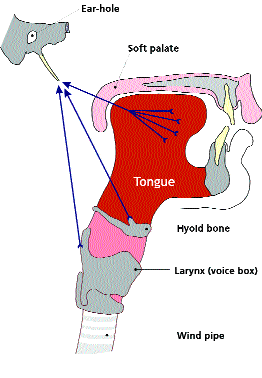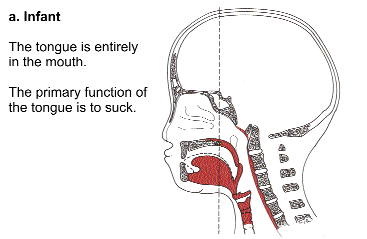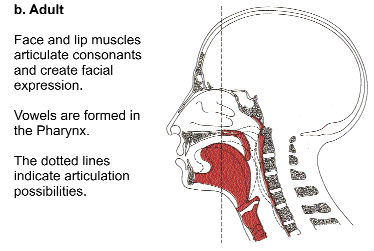Positive Health Online
Your Country

Developing Your Voice as Part of Your Treatment Plan
listed in sound and music, originally published in issue 134 - April 2007
The voice is a significant tool for wielding power and influence. Church and State have always recognized and used this. Now more and more therapists are using it too. They are discovering that their own voice can be either a calming or an energizing influence on a patient, and voice workshops that encourage people to make sound together increase a feeling of wellbeing. Music is powerful, but the most powerful use of music always involves the voice. It is well known in the music profession that you can’t successfully promote a band that has no singer.
Model of the connections between tongue, hyoid bone and larynx
Coordination of tongue, soft palate and throat muscles
develops to produce most articulated speech behind this line.
Comparison of stages of tongue position. The tongue shifts
from mostly in front of the dotted line to mostly behind it
If the voice is so powerful, it is time to ask “How and why does this work?” It may then be possible for everyone to use vocal power as an individual life force that could provide a profound and serious aid to recovery during physical, emotional and psychological trauma. Vocal empowerment may make it easier to take a measure of control during treatment and aid the return to the competitive world that much sooner. Empowerment develops from understanding, and to understand the voice we only have to look at young children, because all of the development of vocal empowerment is there.
Over the last 100,000 years, we have developed the power of sophisticated speech, upright posture and an enlarged cerebral cortex that gives us control of the development of our own potential, and control of the world around us. This evolutionary development is repeated in each child between birth and six years old.
The larynx (i.e. voice box) is connected to the tongue through the hyoid bone. To facilitate simultaneous sucking and nose breathing in the infant, the tongue begins life entirely in the mouth. When the infant begins to push itself up from the floor at about three months the resultant stretch on the front of the body begins to shift the tongue downwards and backwards to a position in the pharynx (throat) where the tongue forms a right-angle, with two-thirds in the pharynx and one-third in the mouth. The larynx, which contains the folds of tissue responsible for the regulation of breathing and sound, also shifts down the throat. This ‘right-angled’ tongue and low larynx allow the tongue to spring backwards to articulate consonants. Thus, although all higher species communicate with vowel sounds by changing the shape of the pharynx, we are the only creatures that have sophisticated speech because we are the only species that can make consonants. This shift of the tongue and larynx occurs gradually between two and six. Before then, the whole breathing/vocal system is unstable.[1]![Using all three constrictors of the pharynx for articulating vowels [10]](/img//img/image-article/fac34f/26a.gif)
Using all three constrictors of the pharynx for articulating vowels [10]![Using all three constrictors of the pharynx for swallowing [3]](/img//img/image-article/fac34f/26b.gif)
Using all three constrictors of the pharynx for swallowing [3]
Six Years Old is a Crucial Stage in Human Development
- Upright balance and coordinated posture and its controlling central nervous system matures between six and eight years old;[2]
- The shift of the tongue to adult position is completed;[1]
- Deciduous dentition (first teeth) changes to mixed dentition;[3]
- 90% of head growth and 80% of jaw growth has occurred;[4]
- The balance in the brain tips from right to left in the learning-to-read process (ages 6-7). Lateral and organized thinking is now possible.[2]
Of course the age is approximate, but overall, the watershed of six years old can be plainly seen.
Current Common Problems in Children
Asthma and other breathing problems; allergies and other irritations of mucous membranes in throat and gut; dyslexia, dyspraxia, and other speech, reading and cognitive communication skills, hyper-activity and lack of concentration.
The infant establishes nose breathing during breast feeding, and ideally, this natural breathing is maintained throughout the shift of two-thirds of the tongue into the pharynx. Before six, the child learns to talk and sing, chew and swallow food, read silently and aloud, develops sophisticated communication skills, develops complicated patterns of movement. All these fundamental skills need time, careful monitoring, and a constant element of play to connect right and left brain, if their good development is to be maintained through the ages of 2-6, and the tongue and larynx are to continue their journey, while natural nose breathing is maintained throughout. Above all, they need time if the different skills are to coordinate.
It is my experience that most children are not achieving this maturation of upright balance, coordinated posture and adult tongue position. It can be heard in the poor development of voices, which are generally unclear and limited in pitch, and lack of reading and articulation skills. It can be seen in the weakness of the upper body to carry itself erect and the reluctance to walk any distance. It can be recognized in the breathing-related problems which are now endemic in children and increasing in adults.
However unstable development still is at six years old, the brain and central nervous system will fulfill the demands of growing up through seven, eight, nine, until the tasks become too great and the ability to adapt becomes too limited. That is when health problems begin. Obviously, to prevent this, children must be given more exercise for the body and for the voice. So increase the amount of reading and singing in schools and reintroduce exercise and games. Problems solved? Not necessarily. Not if these activities always happen in separate lessons.
The important characteristic of natural development is the coordination of its separate growth patterns. They have to link up, strengthen and support each other. Below are some pictures of children involved in Early VoiceGym; exercises that use the voice, body and right and left brain together. By cleaning the teeth while singing face muscles are encouraging the tongue to use the palate and not the front teeth to articulate consonants. This ensures good development of the dental arches and prevents crowded teeth. While children rhythmically bounce and sing, the larynx and tongue complete their shift, and vowels are articulated low in the throat. This adds colour and resonance to the developing voice and makes speech clear. They are using stretch bands to exercise the upper body and stimulate posture while reading or singing. Early VoiceGym can change children’s appearance, and appearance is an influence on how children are judged.
The following is an extract from Hyperventilation – the Tip of the Iceberg a report by LC Lum6 from Papworth and Addenbrookes Hospitals, Cambridge. It is a report on ‘the fat folder syndrome’; patients who present bizarre and often unrelated symptoms and are passed from department to department by clinicians who can find no solution to the problem. They are finally diagnosed as ‘anxiety state’ and sent for counselling. He discovered that the common factor in all of these cases was hyperventilation, not at an instantly recognizable pathological level, but as a constant, moderate level of persistent over-breathing.
“Symptoms (of hyperventilation) may show up anywhere in any organ, in any system, for we are dealing with a profound biochemical disturbance. Such patients are pursued relentlessly, with every investigative device known to modern science, and end up with the label of ‘anxiety state’.”
The first thing I check in a voice of any age is whether their habitual breathing is putting too much pressure on the vocal folds in the larynx. I sit the voice’s owner on a physio ball and invite them to bounce up and down while they sing and keep their feet on the floor. This has the effect of increasing the natural down-spring of the larynx and encouraging it into a lower position. If the result of the bouncing is extra resonance and ease of both singing and speech, you can be fairly sure that this voice is suffering from Lum’s description of ‘moderate hyperventilation’. Adult voice development that reduces over-breathing may aid any of the symptoms found by Lum in the ‘fat folder’. Work to develop and improve the vocal instrument in language and singing is fundamental to the improvement of language and communication skills. According to Simpson7 this is also personal empowerment.
“Language has become more than a means of communication in man. It is one of the principle means of thought, memory, introspection, problem-solving and all other mental activities.”[7]
VoiceGym is already successfully used to help correct the following problems:
Voice Loss in School Teachers and Other Hard Working Voices.
There is currently no training policy for voice development and maintenance for anyone becoming a professional voice. A good voice is assumed to be ‘a gift’. As speech is such a unique human development it is difficult to imagine a profession where learning how to play the vocal instrument would not be important. It is surely an even more serious omission in teaching, where young voices in their charge need the role models for speech and language skills. VoiceGym is extensively used by teachers to fill this void.
Functional Orthodontics
Many dentists and orthodontists have realized that encouraging facial growth and good dental occlusion makes more sense than waiting until teeth have crowded. 90% of head growth and 80% of jaw growth has occurred by six years old and it is then possible to detect underdevelopment of the facial bones in relation to the rest of the skull. Apart from genetic predisposition, the greatest influence on facial development is the position of the tongue.[8,9,10] Breast feeding places the action of sucking at the back of the mouth, from where tongue balance should gradually tip backwards, and downwards but once chewing is established continued sucking, of teats on bottles, cups with tops and teats to reduce mess, boxes of juice with straws, and even bottles of water (a good idea) that you suck (a bad idea), will retain the tongue forward and in the floor of the mouth. Add the thumb or fingers while video-watching and – parents, begin now! to save the money for the very expensive orthodontic procedure to save your child’s adult teeth and prevent the ceiling that will cap their potential.[5]
Temporo-Mandibular Dysfunction (TMD)
The jaw is housed in a three-way sliding joint, the temporo-mandibular joint (TMJ). Chewing and swallowing should exercise the three-way movements of the jaw in this joint, developing and maintaining maximum range of freedom. A western diet of soft food and the ‘four white devils’ – white sugar, white flour, salt and pasteurized milk – was discovered in the 1930s by Weston Price11 to be responsible within two generations for malformation of the bone structure of the jaw and the rising incidence of TMD. VoiceGym Exercises encourage jaw ligaments to stretch, and ensure that everyone gains and understands efficient jaw function. Many orthodontists treating TMD use VoiceGym to give the jaw a greater range of freedom, rebalance tongue and face muscles when wearing dental appliances, and educate patients to prevent further damage.
Problems of the Digestive Tract
If we do not chew and swallow food with a good muscular action, food does not leave the pharynx energetically enough to stimulate the gut to do its job.
To promote a good muscular swallow, the pharynx is divided into three sections that contract in descending order, the first one being part of the oral cavity. The voice, suspended in the gut, is in a unique position to exercise your swallow every time you speak or sing vowels, as these are made by shaping the space formed by the back of the tongue and all three constrictors of the pharynx.
If less than two-thirds of the tongue lies in the pharynx and the larynx remains high, vowels will be shaped by only the top two constrictors. The third, lowest part of the pharynx will not be exercised at all by speech and will over time lose muscular coordination with the other two. Food may then not leave the pharynx energetically from this last part of the pharynx and reflux may occur. VoiceGym exercises correct tongue position and all three constrictors of the pharynx.
Pelvic Floor
According to figures produced by the NHS, one is five women has problems of incontinence. The bladder is supported by the pelvic floor, which should be activated each time you sing or speak.
It is reassuring to know that we have such a strong personal power that will work for us all of our lives and all we have to do is develop it. But if more time, attention and up-to-date information were applied to the voice, balance and posture of children, maybe we would have fewer problems and more potential as adults. For countless reasons, development of the natural resting position of the tongue at six years old is crucial.
References
1. Crelin ES. The Human Vocal Tract, Anatomy, Function, Development, Evolution. Vantage Press, New York. ISBN 053306967X. 1987.
2. Goddard S. Reflexes, Learning and Behaviour, A Window into the Child’s Mind. Fern Ridge Press, OR. IBSN 0961533285. 2002.
3. Hiatt J and Gartner L. Textbook of Head and Neck Anatomy. Williams and Williams, Baltimore MD. ISBN 068303975X. 1987.
4. Vanderlinden F. Facial Growth and Facial Orthopedics. Quintessence Publishing Co. ISBN 1850970041. 1986.
5. Caine A. Voice Loss in Performers: A Pilot Treatment Programme to Test the Effect on the Voice of Correcting Structural Misalignment. Logopedics. Phoniatrics, and Vocology. 23 (suppl.1): 32-37. 1998.
6. Lum LC. Hyperventilation – The tip of the Iceberg. Journal of Psychosomatic Research. 19: 375-383. 1975.
7. Simpson GG. The Biological Nature of Man. in Washburn SL and Jay PC eds. Perspective on Human Evolution. 1: Holt, Reinhart and Winston, New York. 1968.
8. Rocabado M, Johnstone BE, Blakney M. Physical therapy and dentistry: an overview. Journal of Craniomandibular Practice. 1: 47-49. 1983.
9. Mew J. Tongue Posture. British Journal of Orthodontics. 8: 203-211. 1981.
10. Caine A. How Voice Exercises can Assist in Dental Treatment. 3rd Barcelona Orthodontic Meeting. Catalonia Dental Association, Barcelona, Spain. 13-15 March 2003.
11. Price WA. Nutrition and Physical Degeneration. Price Pottenger Foundation, Lemon Grove CA. ISBN 0879838167. 2000.
Further Information
Early VoiceGym, VoiceGym and other VoiceGym publications are available from www.voicegym.co.uk
Comments:
-
No Article Comments available